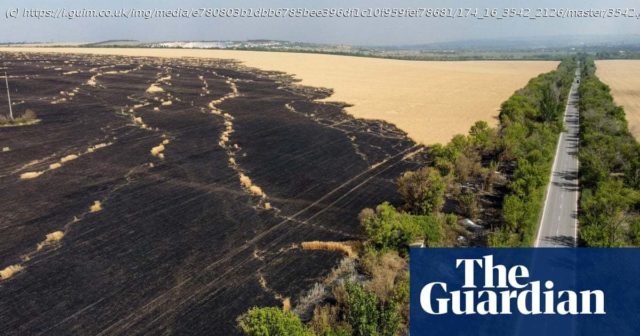Array
Toxic smoke, contaminated rivers, poisoned soil, trees reduced to charred stumps, nature reserves pocked with craters: the environmental toll from Russia’s war with Ukraine, which has been detailed in a new map, might once have been considered incalculable.
But extensive investigations by Ukrainian scientists, conservationists, bureaucrats and lawyers are now under way to ensure this is the first conflict in which a full reckoning is made of environmental crimes so the aggressor can be held to account for a compensation claim that currently stands at more than $50bn (£42bn).
The environment ministry has set up a hotline for citizens to report cases of Russian “ecocide”, which so far number 2,303, and issues weekly updates of the tally. The latest edition estimates that in the past year:
Altogether the losses from land, water and air pollution amounted to $51.4bn, estimated Oleksandr Stavniychuk, the deputy head of the department of environmental control and methodology, at a recent workshop in Kyiv.
In part, this is effective wartime propaganda. At a time of heightened climate sensibilities, the Ukrainian government knows it can win hearts and minds by reminding the outside world that it is an environmentally conscious, food-producing, forward-thinking democracy that has been defiled by a fossil-fuel dictatorship that pays as little respect to nature as it does to the sovereignty of its neighbours.
But the implications of opening this new environmental-legal front are further reaching. It is also part of a broader and very modern battle that aims to tap scientific research, information technology, communication strategies and groundbreaking lawsuits in a way that puts a higher value on nature than most nations have recognised until now.
It is almost certainly the most detailed tally of wartime environmental destruction ever undertaken. During the Vietnam war, there was an outcry over the use of Agent Orange defoliants. In the Gulf war, considerable attention was focused on the burning of oil wells. But there has been nothing with the same range and ambition as the hotchpotch assessments now under way by civil society, universities and the government.
Those involved in this collective intelligence operation would not normally be classified as combatants, but much of their work requires considerable courage.
Kateryna Polyanska is a young landscape ecologist who travels the country, taking samples from bomb craters and photographs of environmental damage in national parks. This requires trips close to conflict zones and areas that have not yet been cleared of unexploded ordnance. The dangers are very real. On one trip, she came across a fox that had been killed by a mine. On another, she could hear the sound of nearby shelling. But she feels the risk is worth taking.
“Last year, I started doing this investigation by computer using only satellite images, but I decided I needed to see it with my own eyes,” she said. “War is not just about direct impacts, it is also the destruction of our nature and environment.”
At first, she was afraid to enter the craters, some of which are more than 3 metres deep. But after she had done 20, she jokes that she became a crater connoisseur.
The samples are sent back to a laboratory where they are tested for toxic chemicals, such as white phosphorus.






